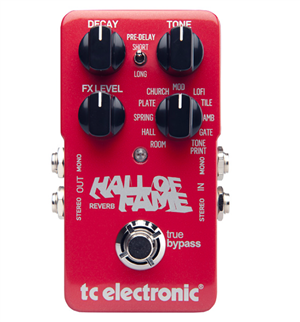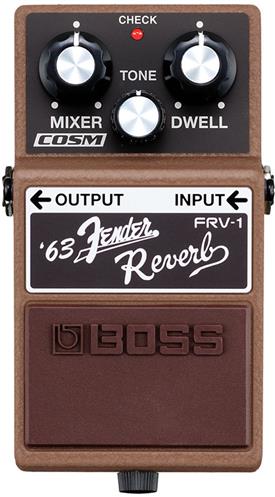

Just a couple of the many popular reverb effects pedals on the market
Reverb, short for reverberation, is a series of dense multiple reflections of a sound created by multiple, blended and random repetitions of that sound. Think of a person singing in a room, maybe a bathroom. After the initial sound, their voice bounces around the room really quickly, creating ambiance. Reverb is an attempt to create this naturally occurring ambiance through effects.
There are many types of reverb units. Some of the earliest forms were acoustic chamber reverbs, in many cases just a bathroom or stairwell with a separate mic catching reflected sounds that were then mixed with the original dry signal. From analog to digital models, the choices are vast. Most studios now have a plethora of digital choices, but many larger studios still offer plate reverbs or chambers.
Reverb is an incredibly important effect that can add life to a track. How you use it is totally up to you. Reverb can be subtle or blatant, sound natural or add interesting flavors to the mix through an exaggerated use of the effect. Using it effectively takes skill, experience and knowing the right techniques, but it is not a difficult effect to understand and use well.
Although most people have a pretty good idea what reverb is, some may still stick to presets and shy away from programming their own virtual spaces. Only a little work is needed to learn the basics to achieve a truly bespoke sound through personalizing your reverbs.
Typical parameters of reverb units include room type, such as hall, room, plate and possibly cathedral. The size controls the size of the room; hence the longer the reverb time, the larger the room simulated by the effect. Decay time is the time it takes the effect takes to return to “silence.” Pre-delay is the delay time between the sound and the effect. In natural situations, it takes time for the sound to reach a wall or surface and then return, so sometimes playing with this level can help create a natural-sounding reverb. Diffusion is the thickness or denseness of the reverb.
One of the most important controls on reverb units is the wet/dry mix. This controls how much of the original signal is returned with the effected sound. Wet refers to the effected sound and dry refers to the original uneffected sound.
Some Tips to Try
– Faster songs are often helped by shorter reverbs. After a certain tempo, the effect is lost before the next sound arrives, which can create a muddiness. Leave those longer reverbs for slower or sparser songs.
– For sound sources like drums that require many tracks to achieve a solid sound, try routing all the drum tracks to one reverb unit. This can help place the sounds in a specific room or sound and help them create their own space in the mix.
– Don’t send every track in your mix to reverb. Leaving some tracks dry can leave your vocal’s reverb room to shine and can help to highlight the tracks that do have reverb.
– Presets are usually well-thought-out patches, but don’t be afraid to twist some knobs and just listen. What you always do may not always work with every song. Variation is key to originality and uniqueness.
– Vocals and acoustic instruments become lush and thick when using a plate reverb, but applying too much reverb can detract from the clarity and intelligibility of a vocal track. Take care when applying reverb to a vocal.
– Try sending different effects into your reverb. Send your vocal to a delay and then to reverb and try the process in the reverse order to compare the difference.
– Try different manufacturers and types of reverb to keep your songs interesting. Each company has specific algorithms that control their effects, so mixing different types can help you find new ways work with your effects.
In closing, working with reverb can add space and life to your recordings, making them more natural sounding or sending them deep into space. As always, explore new ways to achieve your desired results. Just as with other tools, both may be screwdrivers yet they will each work best in different situations or for different sized screws. Until next time, try new things to bust out of your ruts and you’ll often be pleasantly surprised.













